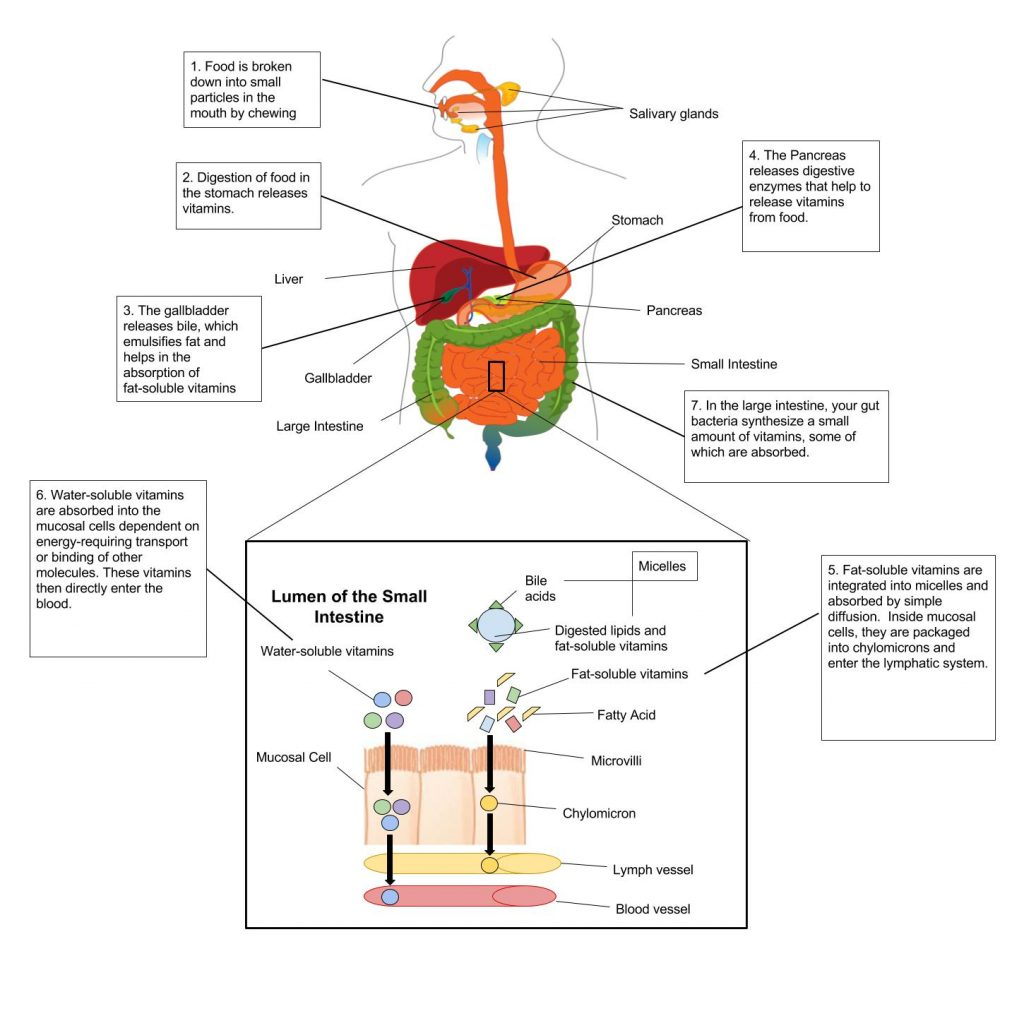8.2: Classification of Vitamins and Minerals
- Page ID
- 39989
Vitamins and minerals are only needed in small quantities in the body, but their role is essential to overall health and proper functioning of all body systems. And while many vitamins and minerals work together to perform various functions in the body, they are classified based on their independent characteristics. These characteristics impact not only how we obtain them in our diets, but also how we absorb them and store them, as well as how we experience deficiencies or toxicities when too little or too much is consumed. After we review the classifications for vitamins and minerals, we will examine key vitamins and minerals based on their similar functions to further highlight the importance of how these micronutrients work together.

Vitamins
The name “vitamin” comes from Casimir Funk, who in 1912 thought “vital amines” (similar to amino acids) were responsible for preventing what we know now as vitamin deficiencies. He coined the term “vitamines” to describe these organic substances that were recognized as essential for life, yet unlike other organic nutrients (carbohydrates, protein, and fat), do not provide energy to the body. Eventually, when scientists discovered that these compounds were not amines, the ‘e’ was dropped to form the term “vitamins.”1
Classification of Vitamins
Vitamins are essential, non-caloric, organic micronutrients. There is energy contained in the chemical bonds of vitamin molecules, but our bodies don’t make the enzymes to break these bonds and release their energy; instead, vitamins serve other essential functions in the body. Vitamins are traditionally categorized into two groups: water-soluble or fat-soluble. Whether vitamins are water-soluble or fat-soluble can affect their functions and sites of action. For example, water-soluble vitamins often act in the cytosol of cells (the fluid inside of cells) or in extracellular fluids such as blood, while fat-soluble vitamins play roles such as protecting cell membranes from free radical damage or acting within the cell’s nucleus to influence gene expression.

One major difference between water-soluble and fat-soluble vitamins is the way they are absorbed in the body. Water-soluble vitamins are absorbed directly from the small intestine into the bloodstream. Fat-soluble vitamins are first incorporated into chylomicrons, along with fatty acids, and transported through the lymphatic system to the bloodstream and then on to the liver. The bioavailability (i.e., the amount that gets absorbed) of these vitamins is dependent on the food composition of the diet. Because fat-soluble vitamins are absorbed along with dietary fat, if a meal is very low in fat, the absorption of the fat-soluble vitamins in that meal may be impaired.

Fat-soluble and water-soluble vitamins also differ in how they are stored in the body. The fat-soluble vitamins—vitamins A, D, E, and K—can be stored in the liver and the fatty tissues of the body. The ability to store these vitamins allows the body to draw on these stores when dietary intake is low, so deficiencies of fat-soluble vitamins may take months to develop as the body stores become depleted. On the flip side, the body’s storage capacity for fat-soluble vitamins increases the risk for toxicity. While toxic levels are typically only achieved through vitamin supplements, if large quantities of fat-soluble vitamins are consumed, either through foods or supplements, vitamin levels can build up in the liver and fatty tissues, leading to symptoms of toxicity.
There is limited storage capacity in the body for water-soluble vitamins, thus making it important to consume these vitamins on a daily basis. Deficiency of water-soluble vitamins is more common than fat-soluble vitamin deficiency because of this lack of storage. That also means toxicity of water-soluble vitamins is rare. Because of their solubility in water, intake of these vitamins in amounts above what is needed by the body can, to some extent, be excreted in the urine, leading to a lower risk of toxicity. Similar to fat-soluble vitamins, a toxic intake of water-soluble vitamins is not common through food sources, but is most frequently seen due to supplement use.
| Characteristics of Fat-Soluble Vitamins | Characteristics of Water-Soluble Vitamins |
|
Protect cell membranes from free radical damage; act within the cell’s nucleus to influence gene expression |
Act in the cytosol of cells or in extracellular fluids such as blood |
|
Absorbed into lymph with fats from foods |
Absorbed directly into blood |
|
Large storage capacity in fatty tissues |
Little to no storage capacity |
|
Do not need to be consumed daily to prevent deficiency (may take months to develop) |
Need to be consumed regularly to prevent deficiency |
|
Toxicity is more likely |
Toxicity is rare |
Table 8.1. Characteristics of fat-soluble and water-soluble vitamins.
Minerals
Similarly to vitamins, minerals are micronutrients that are essential to human health and can be obtained in our diet from different types of food. Minerals are abundant in our everyday lives. From the soil in your front yard to the jewelry you wear on your body, we interact with minerals constantly. Minerals are inorganic elements in their simplest form, originating from the Earth. They can’t be broken down or used as an energy source, but like vitamins, serve essential functions based on their individual characteristics. Living organisms can’t make minerals, so the minerals our bodies need must come from the diet. Plants obtain minerals from the soil they grow in. Humans obtain minerals from eating plants, as well as indirectly from eating animal products (because the animal consumed minerals in the plants it ate). We also get minerals from the water we drink. The mineral content of soil and water varies from place to place, so the mineral composition of foods and water differs based on geographic location.2

Classification of Minerals
Minerals are classified as either major minerals or trace minerals, depending on the amount needed in the body. Major minerals are those that are required in the diet in amounts larger than 100 milligrams each day. These include sodium, potassium, chloride, calcium, phosphorus, magnesium, and sulfur. These major minerals can be found in many foods. While deficiencies are possible with minerals, consuming a varied diet significantly improves an individual’s ability to meet their nutrient needs. We’ll discuss the concern of both deficiencies and toxicities of specific minerals later in this unit.
Trace minerals are classified as minerals required in the diet in smaller amounts, specifically 100 milligrams or less per day. These include iron, copper, zinc, selenium, iodine, chromium, fluoride, manganese, and molybdenum. Although trace minerals are needed in smaller amounts, a deficiency of a trace mineral can be just as detrimental to your health as a major mineral deficiency.

Minerals are water-soluble and do not require enzymatic digestion. They are absorbed directly into the bloodstream, although some minerals need the assistance of transport proteins for absorption and transport in blood.
Minerals are not as efficiently absorbed as most vitamins, and many factors influence their bioavailability:
- Minerals are generally better absorbed from animal-based foods. Plant-based foods often contain compounds that can bind to minerals and inhibit their absorption (e.g., oxalates, phytates).
- In most cases, if dietary intake of a particular mineral is increased, absorption will decrease.
- Some minerals influence the absorption of others. For instance, excess zinc in the diet can impair iron and copper absorption. Conversely, certain vitamins enhance mineral absorption. For example, vitamin C boosts iron absorption, and vitamin D boosts calcium and magnesium absorption.
- As is the case with vitamins, mineral absorption can be impaired by certain gastrointestinal disorders and other diseases, such as Crohn’s disease and kidney disease, as well as the aging process. Thus, people with malabsorption conditions and the elderly are at higher risk for mineral deficiencies.
Attributions:
- University of Hawai‘i at Mānoa Food Science and Human Nutrition Program, “Vitamins: Introduction,” CC BY-NC 4.0
- University of Hawai‘i at Mānoa Food Science and Human Nutrition Program, “Minerals: Introduction,” CC BY-NC 4.0
- Micronutrients Overview Kansas State University Human Nutrition CC BY 3.0
References:
- 1Carpenter, K. J. (2003). A short history of nutritional science: part 3 (1912–1944). The Journal of nutrition, 133(10), 3023-3032.
- 2Linus Pauling Institute-Micronutrient Information Center. (2020). Minerals.https://lpi.oregonstate.edu/mic/minerals
Image Credits:
- “Variety of Fruits in Tray” photo by Danielle MacInnes on Unsplash (license information)
- Figure 8.1. “Classification of vitamins as water-soluble or fat-soluble” by Allison Calabrese is licensed under CC BY 4.0
- Figure 8.2. “Absorption of Fat-Soluble and Water-Soluble Vitamins” by Allison Calabrese is licensed under CC BY 4.0
- Table 8.1. “Characteristics of fat-soluble and water-soluble vitamin” by Heather Leonard is licensed under CC BY 4.0
- “Green-leafed Vegetables” photo by Kenan Kitchen on Unsplash (license information)
- Figure 8.3. “Classification of major and trace minerals” by Allison Calabrese is licensed under CC BY 4.0


